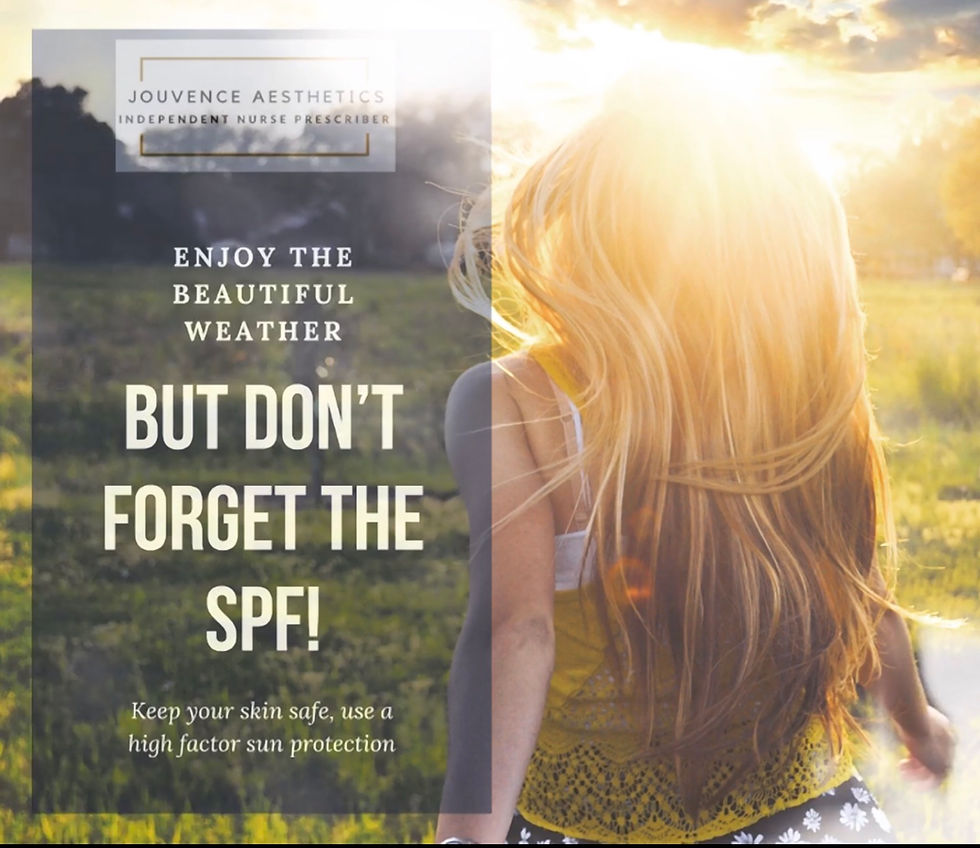Jouvence Aesthetics - Sun Safety at home
- MOIRA GROBICKI
- May 26, 2020
- 3 min read
Advice for adults and children on sunscreen and sun safety in the UK

As most people know sunburn increases your risk of skin cancer. It also causes skin ageing, pigmentation, lines, wrinkle, loss of collagen and elastin. Sunburn and sun damage doesn't just happen on holiday – you can burn and damage your skin in the UK, even when it's cloudy. There's no safe or healthy way to get a tan and a tan doesn't protect your skin from the sun's harmful effects.
Aim to strike a balance between protecting yourself from the sun and getting enough vitamin D from sunlight. We need vitamin D to protect our immune system to fight off any virus', if you feel you are not getting enough sunlight it's worth taking a vitamin D supplement.
Sun safety tips
Spend time in the shade when the sun is strongest. In the UK, this is between 11am and 3pm from March to October.
Make sure you:
* spend time in the shade between 11am and 3pm
* make sure you never burn
* cover up with suitable clothing and sunglasses
* take extra care with children
* use at least factor 30 sunscreen daily
What factor sunscreen (SPF) should I use?
Don't rely on sunscreen alone to protect yourself from the sun. Wear suitable clothing and spend time in the shade when the sun's at its hottest.When buying sunscreen, the label should have:
* a sun protection factor (SPF) of at least 30 to protect against UVB
* at least 4-star UVA protection
UVA protection can also be indicated by the letters "UVA" in a circle, which indicates that it meets the EU standard. Make sure the sunscreen is not past its expiry date. Most sunscreens have a shelf life of 2 to 3 years. Don't spend any longer in the sun than you would without sunscreen.
What are the SPF and star rating?
The sun protection factor, or SPF, is a measure of the amount of ultraviolet B radiation (UVB) protection. SPFs are rated on a scale of 2-50+ based on the level of protection they offer, with 50+ offering the strongest form of UVB protection. The star rating measures the amount of ultraviolet A radiation (UVA) protection. You should see a star rating of up to 5 stars on UK sunscreens. The higher the star rating, the better. The letters "UVA" inside a circle is a European marking. This means the UVA protection is at least one third of the SPF value and meets EU recommendations. Sunscreens that offer both UVA and UVB protection are sometimes called broad spectrum.
How to apply sunscreen
Most people don't apply enough sunscreen. As a guide, adults should aim to apply around:
* 2 teaspoons of sunscreen if you're just covering your head, arms and neck
* 2 tablespoons if you're covering your entire body while wearing a swimming costume
If sunscreen is applied too thinly, the amount of protection it gives is reduced. If you're worried you might not be applying enough SPF30, you could use a stronger SPF50 sunscreen.
If you plan to be out in the sun long enough to risk burning, sunscreen needs to be applied twice:
* 30 minutes before going out
* just before going out
Sunscreen should be applied to all exposed skin, including the face, neck and ears – and head if you have thinning or no hair – but a wide-brimmed hat is best if you have no hair.
Sunscreen needs to be reapplied liberally and frequently, and according to the manufacturer's instructions.
This includes applying it straight after you've been in water – even if it's "water resistant" – and after towel drying, sweating, or when it may have rubbed off.
There are lots of easy sunscreen sprays on the high st, even ones that you can mist over your make up, so there's no excuse not to 'top up' your sunscreen every couple of hours!
Keep safe in the sun with Jouvence Aesthetics


































Comments